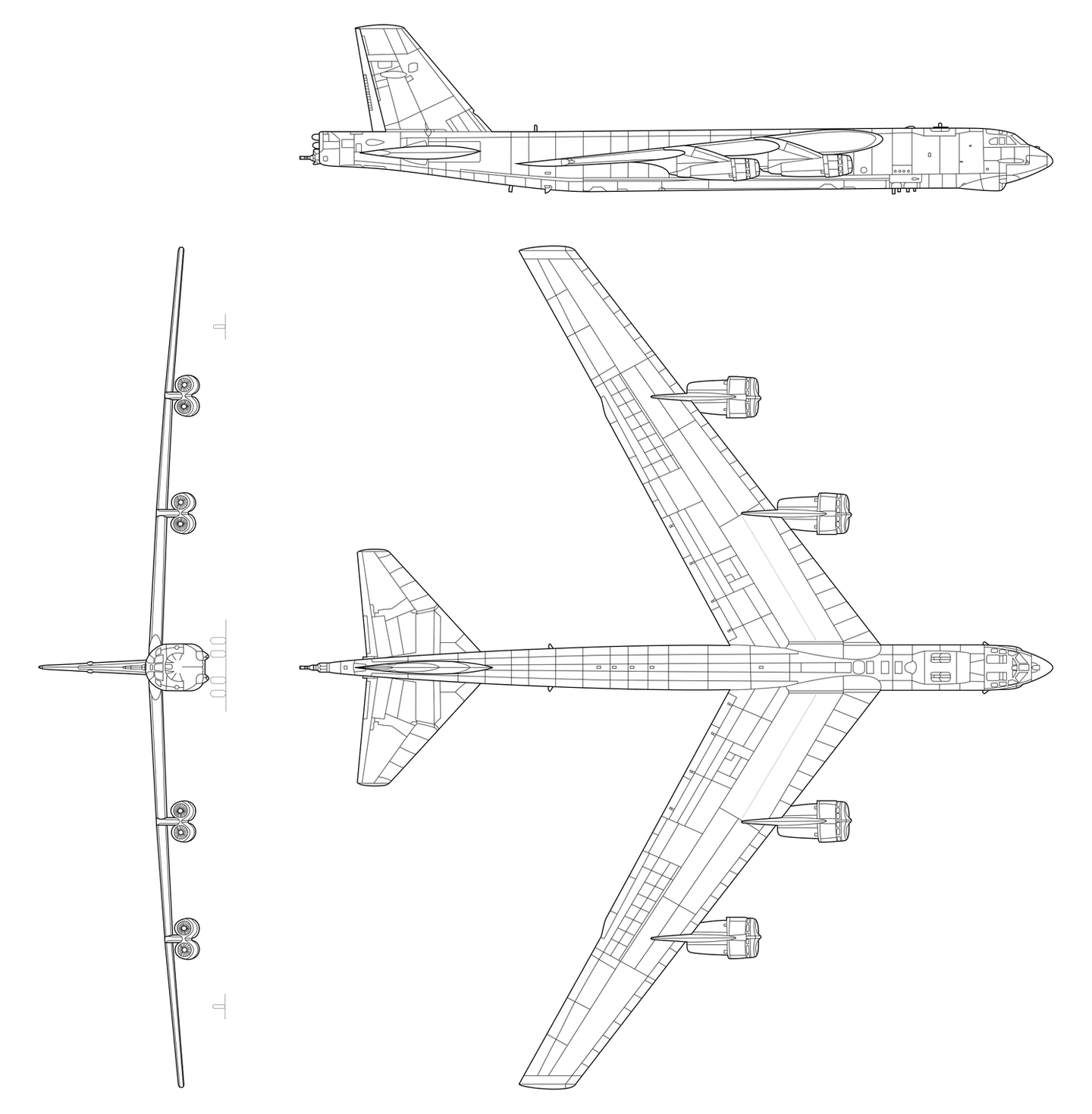Create Your First Project
Start adding your projects to your portfolio. Click on "Manage Projects" to get started
B-52 (Nose Section)
First Flight
April 15, 1952
Location
Vietnam Hangar Ramp
Dimensions & Capacity
Crew: 5 (pilot, copilot, weapon systems officer, navigator, electronic warfare officer)
Length: 159 ft 4 in (48.5 m)
Wingspan: 185 ft 0 in (56.4 m)
Height: 40 ft 8 in (12.4 m)
Empty Weight: 185,000 lb (83,250 kg)
Max Take Off Weight: 488,000 lb (220,000 kg)
Performance
Speed: Maximum – 650 mph (1,050 km/h, 560 kn)
Service Ceiling: 50, 000 ft (15,000 m)
Range: 8,800 mi (14,200 km, 7,600 nmi)
Airworthiness
Static Aircraft
Armament
Guns: 1 × 20 mm (0.787 in) M61 Vulcan cannon originally mounted in a remote controlled tail turret on the H-model, removed in 1991 from all operational aircraft.
Bombs: Approximately 70,000 lb (31,500 kg) mixed ordnance; bombs, mines, missiles, in various configurations.
Loan Status
This aircraft is on loan from the National Museum of the United States Air Force
The Boeing B-52 Stratofortress is an American long-range, subsonic, jet-powered strategic bomber. The B-52 was designed and built by Boeing, which has continued to provide support and upgrades. It has been operated by the United States Air Force (USAF) since the 1950s. The bomber is capable of carrying up to 70,000 pounds (32,000 kg) of weapons and has a typical combat range of more than 8,800 miles (14,080 km) without aerial refueling.
Beginning with the successful contract bid in June 1946, the B-52 design evolved from a straight-wing aircraft powered by six turboprop engines to the final prototype YB-52 with eight turbojet engines and swept wings. The B-52 took its maiden flight in April 1952. Built to carry nuclear weapons for Cold War-era deterrence missions, the B-52 Stratofortress replaced the Convair B-36 Peacemaker. A veteran of several wars, the B-52 has dropped only conventional munitions in combat. The B-52’s official name Stratofortress is rarely used; informally, the aircraft has become commonly referred to as the BUFF (Big Ugly Fat Fella). The B-52 has been in service with the USAF since 1955. As of June 2019, 58 are in active service, 18 in reserve, and approximately 12 more aircraft in long-term storage. The bombers flew under the Strategic Air Command (SAC) until it was disestablished in 1992 and its aircraft absorbed into the Air Combat Command (ACC); in 2010, all B-52 Stratofortresses were transferred from the ACC to the newly created Air Force Global Strike Command (AFGSC). Superior performance at high subsonic speeds and relatively low operating costs have kept them in service despite the advent of later, more advanced strategic bombers, including the Mach 2+ B-58 Hustler, the canceled Mach 3 B-70 Valkyrie, the variable-geometry B-1 Lancer, and the stealth B-2 Spirit. The B-52 completed sixty years of continuous service with its original operator in 2015. After being upgraded between 2013 and 2015, the last airplanes are expected to serve into the 2050s.
History of Our B-52
1957 – Constructed as a B-52D-60-BO by Boeing at Seattle, Washington, USA.
1 March 1957 – Taken on Strength/Charge with the United States Air Force with s/n 55-0095.
March 1957 – Transferred to 42nd Bombardment (Heavy) Wing (Strategic Air Command), Loring AFB, ME.
October 1959 – Transferred to 92nd Bombardment (H) Wing (SAC), Fairchild AFB, WA.
July 1960 – Transferred to 4170th Strategic Wing (SAC), Larson AFB, WA. Deployed to Fairchild AFB.
July 1962 – Transferred to 4138th Strategic Wing (SAC), Turner AFB, GA.
February 1963 – Transferred to 484th Bombardment (H) Wing (SAC), Turner AFB, GA.
Deployed to McCoy AFB, FL.
March 1966 – Transferred to 340th Bombardment (H) Wing (SAC), Bergstrom AFB, TX.
July 1966 – Transferred to 306th Bombardment (H) Wing (SAC), McCoy AFB, FL. While based at McCoy AFB, this aircraft deployed to Anderson AB, Guam; Kadena AB, Japan; Castle AFB, CA; and U Tapao RTAFB, Thailand.
April 1970 – Transferred to 22nd Bombardment (H) Wing (SAC), March AFB, CA. While based at March AFB, the aircraft deployed to Anderson AB, Guam, and U Tapao RTAFB, Thailand.
June 1972 – Transferred to 7th Bombardment (H) Wing (SAC), Carswell AFB, TX.
May 1983 – Transferred to Chanute Technical Training Center, Chanute AFB, Rantoul, IL.
May 1983 – Redesignated as GB-52D.
June 1990 – Struck off Strength/Charge from the United States Air Force. At some point, the aircraft was broken up and the cockpit section was used as a crew extraction trainer for fire-fighting trainees.
17 September 2015 – To Valiant Air Command Museum, Space Center Executive Airport (North East Side), Titusville, FL.











